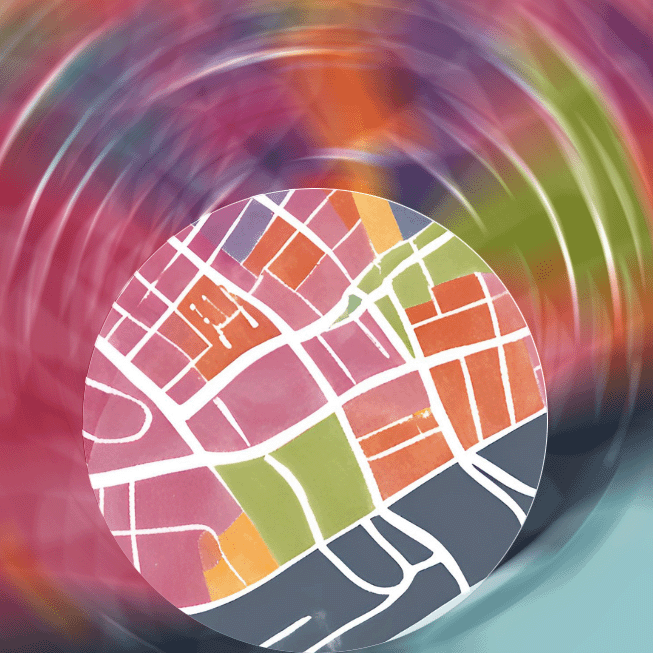In the Zones (of Narrative Change work)
“The question I am posing is whether an explicit recognition of the zones of narrative change work might enable us to activate each zone more consciously. Can we minimize contradiction and boost mutual support for greater and more lasting impact?”
By Brett Davidson
Narrative Lead at the International Resource
for Impact and Storytelling
Edited by
Mia Deschamps
Image credit: stylized zoning map created by AI in Canva Magic Studio; remixed by Mia DeschampsThe Nation magazine recently featured an interview with political theorist Wendy Brown, about her book Nihilistic Times: Thinking with Max Weber. The interview ranges over several topics related to Weber’s thinking, but towards the end the conversation turns to the appropriate relationship (or not) between academia and politics. It got me thinking about the role of narrative in various spheres of life.
Brown, in her discussion of Weber, talks about the need for a ‘moat’ between academic and political life. As I understand the argument, this is not to say that power and politics and values don’t exist or have a place in academia, or that there is no place for critical thinking in politics. Rather, it is that excessive politicization, or the demand that academia serve particular political goals, can interfere with the openness, reflexivity and exploration that are critical to genuine and potentially transformational intellectual inquiry. The point of a moat between the two realms, according to Brown, is to protect academia as “a space for thinking, exploring, examining, and to be potentially undone by this experience”. On the other hand, politics is—rightly—a very instrumental zone, where battles are fought and won. Brown says: “In Weber’s compressed account: ‘Words in the classroom are plowshares to loosen the soil of contemplative thought; words in the political realm are swords against enemies, weapons.’” In Brown’s view: “To confuse these domains compromises both.”
I found this discussion very helpful, not only in relation to academia and politics, but also in thinking about narrative change.
The term ‘narrative change' is used a lot these days, but since it has many overlapping meanings and entails very different functions and applications, conversations between people who say they do narrative change can sometimes get a little confusing. Related to this, there are several contending or competing conceptions of what narrative change aims to do—the ends of narrative change—and how we should be doing it—the means.
In the interview with The Nation, Brown talks about different zones of life, such as academia and politics, each with its own appropriate set of goals, ethics, means and ends. I wonder if a recognition of something parallel in the world of narrative change would help clear up some of the confusion in the field, and help us navigate differences over appropriate ends and means. I think this would be useful because when we don’t understand the distinctions between different areas of work, their goals and methods, we can find ourselves not only talking but also working at cross-purposes, and in some cases applying inappropriate methods for the ends we’re trying to achieve. For example, we often talk of narrative change as being a long term process. But if we see it only as long-term, we risk missing, and thus ceding by default, crucial short-term contests (whose results place even greater obstacles in the way of our longer term goals).
I can think of at least 3 zones of narrative change work relevant for this discussion. There might be other zones of narrative work that I’m missing, but these are three that occur to me as useful. There are many individuals and organizations that work across more than one of these zones, and the boundaries may be a little blurry - particularly between the second and third zones. Still, making these distinctions can be helpful.
The Zone of Politics
Firstly, there is narrative change work that takes place in the zone of political contests, such as elections, ballot measures, and policy and legislative battles. Here the end of narrative change work is to win a relatively short-term political battle: to mobilize narrative power in order to gain real world political power. The timeframe of this work is days, weeks and months. Narrative is wielded very instrumentally, as a weapon. The aim is to win, and success or failure can be seen in polls or electoral outcomes. The means are tailored towards the win: the changed policy, the election or similar triumph. The focus is often on developing, testing and deploying strategic messages that energize a base, and win over persuadables.
Narrative structures in political messages often follow a specific format, aimed at achieving a clear goal. Researchers applying the Narrative policy Framework have, for example, looked at how archetypes such as heroes, villains and victims are activated in narratives during policy contests. Then there is the Race Class Narrative Framework , which aims to build cross-racial solidarity in order to win progressive victories. Messages using this framework begin by identifying shared values, they go on to name specific villains and mention that the villains use scapegoating to divide and distract. They then paint a vision of a better future and end with a clear call to action. In the zone of politics, it’s not helpful or responsible to have too much openness, ambiguity or complexity. The aim is to find a single winning narrative and to have everyone get behind it. Roleplayers in this zone include Anat Shenker-Osorio, Ian Haney Lopez, and organizations like We Make The Future.
The Zone of Culture
A second zone of narrative work is that of culture change. Here, the aim is to bring about a widespread shift in mindsets, changes in social norms and values, and changes in social identity. The timeframe is long term: a decade or decades. The scope is a whole society or culture, and success or failure can therefore be complicated to define and measure. An example is the Pop Culture Collaborative’s Becoming America Fund, which aims to “ignite public imagination about our pluralist future”. Whereas narrative work in the zone of politics aims to narrow down, to push a single winning narrative (for example, one that mobilizes people to vote for a ballot measure ensuring clean air), here the aim is to open up, to trouble and destabilize existing cultural meta-narratives by introducing complexity, nuance and openness. In the zone of culture, people talk about the danger of a single story. Narrative structures might include familiar archetypes such as heroes, villains and victims but the task of narrative work in this zone is to destabilize seemingly set-in-stone notions of who in society might fill those roles—to introduce layers of meaning, and ambiguity. The focus of the work is not on deploying strategic political messages, but on cultural interventions, such as TV shows, movies, games, and popular music with a diverse and inclusive array of characters, and storylines and imagery that widen imaginations and point to new possible futures. The connection between content and impact is unclear, diffuse, long term and often unpredictable. Aside from the US-based Pop Culture Collaborative, other prominent roleplayers in this zone include Puentes, and the Global Narrative Hive.
The Zone of Social Connection
The third zone of narrative change work is that of social connection and cohesion. The end-goal of narrative work in this zone is to counter polarization, address conflict, bridge differences and create a greater sense of belonging. The time frame is medium to long term, and the scope often starts small—with a particular location or defined group(s) of people, with the aim of widening out, as an expanding circle. Complexity, nuance and openness are important in this zone too. Narrative work in this zone might question our very need for archetypal roles such heroes, villains and victims. Certainly a key aim here is to move away from identifying and targeting villains – to move away from othering. While this narrative work can include use of cultural products, the focus of the work is often on interpersonal interaction, and tends to emphasize narratives of identity rather than those about issues. Often there is an emphasis on listening over talking or telling. Examples and roleplayers in this zone include Horizon’s project, Narrative Engagement Across Difference, and the work of the Othering and Belonging Institute.
Reconciling Our Differences
It should be clear from the descriptions of each zone that their respective ends and means may be in conflict with one another. Identifying villains in the political zone may conflict with the aim of reducing polarization in the social connection zone. The quest to open up and increase the diversity of narratives in the culture change zone may frustrate those working in the political zone who are focused uniting people around a single winning narrative for a short term but crucial win (For example, these pieces by Noam Chomsky and Waleed Shahid argue for the need to be super pragmatic in order to win the short term contests, or risk catastrophe in the longer term).
Since we all agree we are working towards greater social justice, we may need to accept and figure out how to live with zonal conflict. If we recognize the different zones of narrative work and their appropriate means and ends, perhaps we can talk to one another with more clarity and begin to figure out how to do our respective work in a way that – if it can’t immediately support the work of the other zones – at least doesn’t counter it.
More importantly though, a recognition of the distinctions between various zones of narrative work might help us better explore synergies, so that work in each zone actively and intentionally reinforces that in the others.
It is important to remember we all share common values—of social justice, of democracy, of pluralism—so in the long term, we are all working towards the same thing. A social culture that values pluralism is good for democracy in the long term and provides a narrative context that is fertile ground for short-term political messaging to succeed more easily. Approaches to political messaging such as the Race-Class Narrative Framework, that seek to win shorter-term campaigns by building solidarity across differences, should also help usher in longer-term social and cultural change.
It’s also important to note that some organizations or initiatives see themselves as working across more than one of these zones, and work in any one of these areas may feed into the others in unexpected ways. Sometimes, what starts out as a broader culture change effort might narrow and become more politically focused as a key political inflection point nears – in the way we are seeing the K-Hive and memes and sounds across TikTok and Instagram seeking to distill a cultural yearning for joy, hope and possibility, into the person of Kamala Harris ahead of the November presidential election.
A lot of this seems to be happening spontaneously. The question I am posing is whether an explicit recognition of the zones of narrative change work might enable us to activate each zone more consciously so that we can minimize contradiction, and boost any mutually supportive effects for greater and more lasting impact.




